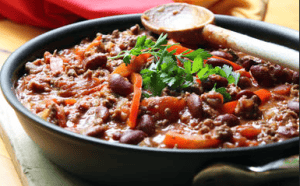 One of the questions I get pretty regularly is “How can I determine the nutrition information of recipes I make at home?” When you’re trying to lose weight or build muscle, or working to ensure you’re giving your body the protein and vitamins and minerals it needs to thrive, knowing the protein, nutrient and calorie content of your meals can be super helpful. But cooking at home using whole foods can make it trickier, as whole foods don’t come with a nutrition label! There is a way to figure out all these values, and with the right tools and tricks it’s not too complicated.
One of the questions I get pretty regularly is “How can I determine the nutrition information of recipes I make at home?” When you’re trying to lose weight or build muscle, or working to ensure you’re giving your body the protein and vitamins and minerals it needs to thrive, knowing the protein, nutrient and calorie content of your meals can be super helpful. But cooking at home using whole foods can make it trickier, as whole foods don’t come with a nutrition label! There is a way to figure out all these values, and with the right tools and tricks it’s not too complicated.
The first few times you do this will be a learning process – expect imperfection. But you’ll get the hang of it quickly. Hang in there!
You’ll need two tools to get an accurate idea of the nutrient profile of your recipes. First, you’ll need to find a recipe analyzer you feel comfortable with. There are dozens available online. I would say they’re all pretty comparable, so check out a few and get a feel for which one seems most user friendly to you. I use this one at Calorie Count. Many of my clients use this one at MyFitnessPal. Spark People has a good one, as does Self Magazine. Here’s one from Fit Watch. Dieticians of Canada also has a good one. Some of these analyzers require you to create an account, but the accounts are free. The benefit of creating an account, though, is that you can save your recipes for future reference and only need to analyze them once.
You’ll also need a decent food scale (I like this one, although there are many to choose from at different price points
).
And now that we’ve got the tools, here’s how you do it:
1. Enter all the ingredients of your recipe into the recipe analyzer of your choice, and tell the analyzer how many servings the finished product will produce. The analyzer will give you the nutrient profile for a serving of your recipe.
2. Prepare the recipe.
3. Weigh the entire finished recipe. Make sure to subtract the weight of the container you’re using to weigh the recipe. You can do this by weighing the empty container before weighing the recipe, or if your scale has a tare function, simply place the container on the scale and press the tare button to zero out the weight reading, then add the finished recipe to the container and the scale will read only the weight of the food.
4. Divide the finished product into servings by weight.
Here’s an example:
Our imaginary example dish is going to be beans and rice. Enter all the ingredients into the analyzer, in this case we’ll enter 2 cups uncooked rice, 1 cup dry beans, 3 carrots, 3 stalks of celery, 2 large tomatoes, a tablespoon of olive oil and a teaspoon of salt (we’re going for simple here). Then we tell the analyzer this recipe makes 4 servings. The analyzer will make it’s calculations and spit out the nutrient profile for one serving. Then, we prepare the recipe. When the recipe is finished, we place the entire dish on the food scale. After figuring out and subtracting the weight of the container the food is in, we determine the finished recipe weighs 36 ounces. We then divide the recipe into 4 equal 9 ounce servings, and either serve and eat, or package up for later. Viola! Home made meal, accurately profiled and divided. You now know your home made meal’s macronutrient, micronutrient and calorie profile.
One benefit of determining the nutrient profile of your recipes is that you can see if they are balanced to meet your goals, and if not, you can alter them. For instance, this beans and rice recipe may be too low in protein for someone on a fat loss diet, so seeing where the protein is coming from can give them ideas for improving the protein balance (perhaps by increasing the bean to rice ratio, or adding another protein dense ingredient). You can also determine if your recipe is calorie dense enough to meet your energy needs, or if it lacks micronutrients you may need to increase your consumption of. Remember, being aware of the nutrient profile of your diet IS NOT and SHOULD NOT be about restriction, it should be about ensuring you are meeting your nutrient and energy (calorie) needs adequately. Spending some time learning about the way your diet balances out over time can help you create new eating habits. Once those habits are in place, you can leave the tracking behind.
Related blog posts:
Calorie Primer
Habit: the Real Key to Weight Loss Success
Body Composition
